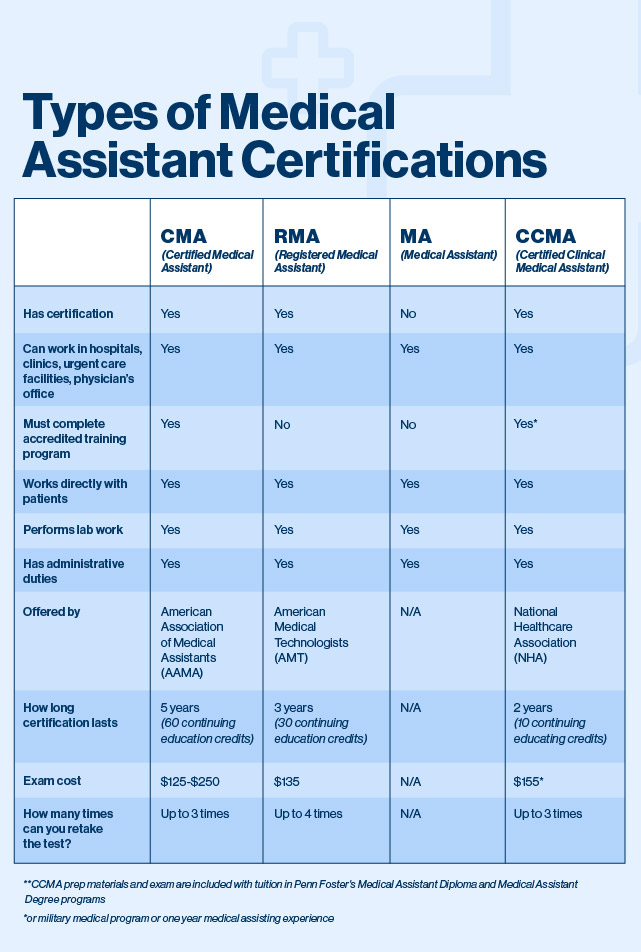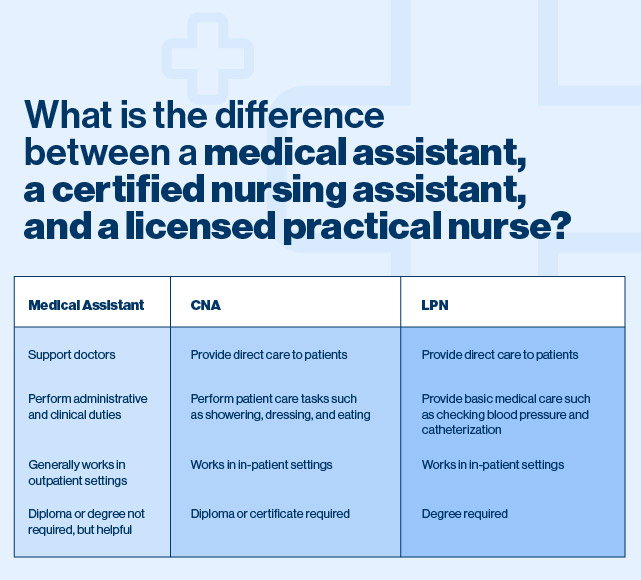
Your Guide to Medical Assistant Duties
Sep 26, 2024
11 min read
Reviewed by Theresa Sinkevich, RMA, Instructor, and Academic Partnership Coordinator for Penn Foster’s Allied Health programs. Learn more about our editorial guidelines.
If you’re looking for an in-demand career that offers plenty of job opportunities and the chance to make a difference, becoming a medical assistant could be the right path for you. In this guide, you’ll learn everything you need to know about becoming a medical assistant, how much medical assistants make, and what the job is like. Click the links below to jump to a specific section or read the whole blog.
Medical assistant duties
Medical assistants support physicians by helping with patients, both directly and indirectly. They’ll take patient vital signs, as well as help with clinical and administrative tasks. Depending on where you work, everyday duties and responsibilities could vary, but, generally, the typical medical assistant duties include
Administrative duties
- Scheduling appointments
- Maintaining and updating electronic health records
- Assisting with medical billing and coding
- Following up with patients regarding tests and procedures
- Working with insurance companies for billing, prior authorizations, and more
- Answering phone calls from patients, other physicians, and medical facilities
- Checking patients in for appointments
Clinical duties
- Speaking with patients prior to seeing the doctor, including covering symptoms, concerns, and issues
- Taking vital signs, such as blood pressure, weight, and temperature
- Assisting with or performing lab tests, like taking bloodwork
- Assisting doctors with patient exams, if needed
- Performing basic wound care, such as cleaning and applying bandages
- Giving patients medication or injections as directed by the doctor
- Sterilizing medical equipment and exam rooms
Medical assistant duties in primary care
In primary care offices, typical medical assistant duties can include
- Scheduling patient appointments
- Following up to remind patients of appointments
- Taking vital signs prior to an exam and recording them in the patient’s electronic health record
- Administering injections, such as vaccinations
- Setting up follow up appointments or coordinating referrals to specialists
- Performing basic procedures, such as flushing a blocked ear or basic wound care
Medical assistant duties in a clinic
Similar to duties in a primary care office, medical assistants who work in clinics or urgent care facilities are often responsible for
- Checking patients in
- Taking vital signs and recording them in the patients record
- Interviewing patients about the reason for their visit and documenting the information for the doctor
- Collecting and preparing things for lab tests, like drawing blood
- Perfoming basic woundcare, such as applying bandages or removing stitches
Medical assistant duties in the back office
Back of office duties for medical assistants can include
- Transmitting prescriptions or prescription refills to pharmacies, as directed by the doctor
- Updating and maintaining patient records
- Processing payments or working with insurance companies on billing
- Filing paperwork or submitting paperwork, such as prior authorizations
- Contacting other doctors for patient records or to set up patient appointments with a specialist
- Inventory and refill office supplies
- Contacting patients to follow up with things like results from lab tests and procedures
Medical assistant duties in a hospital
In a hospital, medical assistants may help with
- Taking patient vital signs
- Helping patients with treatments
- Helping patients with medications
- Preparing patients for testing
- Conducting some tests, like electrocardiograms
- Wound care
- Educating patients on care and follow up measures
Medical assistant duties In OBGYN offices
Similarly to working in other types of doctor’s offices, in an OB/GYN doctor’s office, medical assistants may be responsible for tasks like
- Scheduling appointments
- Updating and maintaining patient records
- Schedule follow up appointments
- Taking patient vital signs
- Assisting the doctor with exams, such as pelvic exams
- Assisting with tests and procedures like PAP smears
- Performing routine tests like pregnancy tests or STI tests
- Following up with patients regarding test results
Where do medical assistants work?
Medical assistants can work in a variety of healthcare settings, but most commonly find jobs in physician’s offices, hospitals, clinics, urgent care facilities, and outpatient care centers. Your daily job duties can vary based on where you work. Your work schedule can also change based on the needs of your employer.
Medical assistants working in a doctor’s office often have the steadiest schedules, working when the office is open. Generally, that means a work schedule from Monday through Friday, 8am to 5pm. You may work earlier or later depending on your doctor’s office hours.
Those medical assistants who work in an urgent care or clinic can have steady hours as well, though they may find themselves working longer hours, nights, and weekends.
Medical assistants who work in hospitals will have the most varied schedule, working whenever they’re needed. That can mean overnight shifts, early mornings, weekends, and holidays.
Read more: Boost Your Income (Top 10 Medical Certifications That Pay Well)
CMA vs medical assistant
Certified Medical Assistants (CMAs), Registered Medical Assistants (RMAs), and Certified Clinical Medical Assistants (CCMAs) do the same job as a medical assistant, but they have recognized industry credentials. To become a CCMA, you need to graduate from an accredited medical assistant program and sit for an exam like the Certified Clinical Medical Assistant (CCMA) certification offered by the National Healthcareer Association (NHA).
To become an RMA, you need to graduate from an accredited program, have at least 5 years of work experience, or have military medical training to qualify to sit for the American Medical Technologists (AMT) Registered Medical Assistant (RMA) Certification. The differences between a CMA and a medical assistant
Types of Medical Assistant Certifications

What is it like being a CMA or medical assistant?
Being a CMA or medical assistant comes with duties and responsibilities that vary depending on where you work. A day in the life of a medical assistant who works in a doctor’s office usually starts in the morning, around 7 or 8am depending on when the office opens to patients.
To start the day, a medical assistant will help open the office, check the patient appointments for the day, pull patient records and charts for those appointments, and make sure any necessary supplies are stocked.
Once the office is open, medical assistants may help check in patients for appointments, call patients with appointment reminders, or help with scheduling. They’ll also take patients back to exam rooms, check their vitals, update their medical records, and take down information about why the patient is visiting. For most of the day, depending on how busy it is, they’ll do this several times.
At the end of the day, medical assistants will help with organizing files, following up with any last-minute calls and requests, and ensuring the office is clean and ready for the next day.
Do medical assistants need to be certified?
No, medical assistants aren’t required to be certified to work in the field. However, most employers prefer to hire certified or registered medical assistants. Being certified shows potential employers in doctor’s offices, hospitals, and healthcare facilities that you have the necessary knowledge to be an asset to the team. It also has a positive impact on your salary! Certified medical assistants can earn as much as $6,000 more per year than non-certified medical assistants.
What is the hardest thing about being a medical assistant?
The hardest thing about being a medical assistant is often dealing with emergencies that can arise and working with difficult patients. However, if you enjoy what you do, the challenges are worth it – and don’t come up as often as you’d think.
What is the most important role of a medical assistant?
Medical assistants have many important tasks, but one of the most important roles is in updating patient information. Patient medical records are vital documents that ensure that they receive accurate and efficient care. Without accurate, up-to-date information, a patient may not receive the right treatment or medication. A medical assistant is a patient’s advocate, someone who makes sure patient needs are understood and met by everyone on the healthcare team.
What is the difference between a medical assistant and a medical office administrator?
Medical office administrators can work in hospitals, doctor’s offices, and clinics, however medical office administrators are usually the first point of contact for patients. Unlike medical assistants, administrators do not care for patients. Instead, they manage the front desk, handle electronic billing and medical records, and perform office managerial duties.
What can a nurse do that a medical assistant can't?
Medical assistants and nurses play different roles within a healthcare team. Medical assistants complete both administrative and clinical tasks, often under the supervision of a doctor. Nurses, on the other hand, can perform a wider range of duties including administering medications, performing routine procedures like catheterization, and educating patients.
Medical assistant salary
The median medical assistant salary was $42,000 per year as of May 2023. What you can make as a medical assistant can vary depending on your experience, where you work, and whether or not you’re certified. Becoming a certified medical assistant can allow you to earn more and take on more responsibilities on the job.
Does being a CMA pay well?
Being a CMA can offer a decent starting salary. The average salary for an entry-level certified medical assistant was $46,887 per year as of August 2024.
How can you make more money as a medical assistant?
Like with any job, you can make more money as a medical assistant with experience and further education. You can also earn more depending on where you work.
What are the highest paid medical assistants?
Highest Paying Medical Assistant Jobs

What's higher than a medical assistant?
After a medical assistant, the next highest role would be a licensed practical nurse (LPN), followed by a registered nurse (RN), advanced practice registered nurse (APRN), and a nurse practitioner.
What's the next step after becoming a medical assistant?
After becoming a medical assistant and working in the field, you may be thinking about advancing your career. In most cases, this will mean pursuing additional credentials and furthering your education. The most common next step for medical assistants tends to be pursuing the career path to become a nurse, so you’ll need to likely earn an associate or bachelor’s degree, as well as take a licensing exam if that interests you.
“I know a lot of nurses and nurse practitioners that started out as certified nursing assistants,” says Jaime Nguyen, Director of Penn Foster Healthcare Programs, “that then went into becoming medical assistants, then became an LPN and then became a nurse. Of course, there are many that actually went straight for it, but [becoming a medical assistant] is a great way to take a step into the field and then start to build and ladder into more advanced training.”
Medical assistant vs CNA vs LPN
There are many roles within the healthcare industry and it can sometimes become difficult to understand the differences between them. For example, since nurses and medical assistants complete some of the same duties, such as recording and updating patient medical histories, it may seem like their roles are very similar. However, there are several differences that set each role apart.
What is the difference between a medical assistant, a certified nursing assistant, and a licensed practical nurse?

Is being a medical assistant worth it?
Being a medical assistant can be challenging, hard work but if you love helping others and making a difference, it can absolutely be worth it! Medical assisting is a rewarding job that allows you to work directly with patients and see the difference the work you do makes.
According to Jaime Nguyen, Director of Allied Health Programs at Penn Foster, in a Facebook Live focused on healthcare programs, “We can underestimate how incredibly rewarding it is, too. It’s one of the few professions in which you can directly affect someone’s life.”
What are the disadvantages of being a medical assistant?
Medical assisting is a rewarding job, but it does come with some disadvantages. The cons of being a medical assistant include
- Long hours or a varied work schedule
- Stress
- Having to report to higher ups
- Being on your feet all day
- Working closely with others
- Working with needles
However, for those who are passionate about working in healthcare, the pros of being a medical assistant far outweigh the cons.
Are medical assistants happy?
Working in any role in healthcare can be tough, both emotionally and physically. But most medical assistants are happy in their roles. According to Career Explorer, which conducts an ongoing survey of professionals in a variety of industries, medical assistants have an average level of job satisfaction. This puts them in the top 50% of careers!
Become a medical assistant online
If you know that working in healthcare is the right move for you, becoming a medical assistant online can help you take the next steps toward the job you want. With Penn Foster’s online Medical Assistant Career Diploma and Medical Assistant Associate Degree, you can prepare to become a CMA on your schedule, from home. To learn more about which program is right for you or to get started today, contact our expert Admissions Specialists at 1-888-427-6500!
*Source: U.S. Bureau of Labor Statistics




